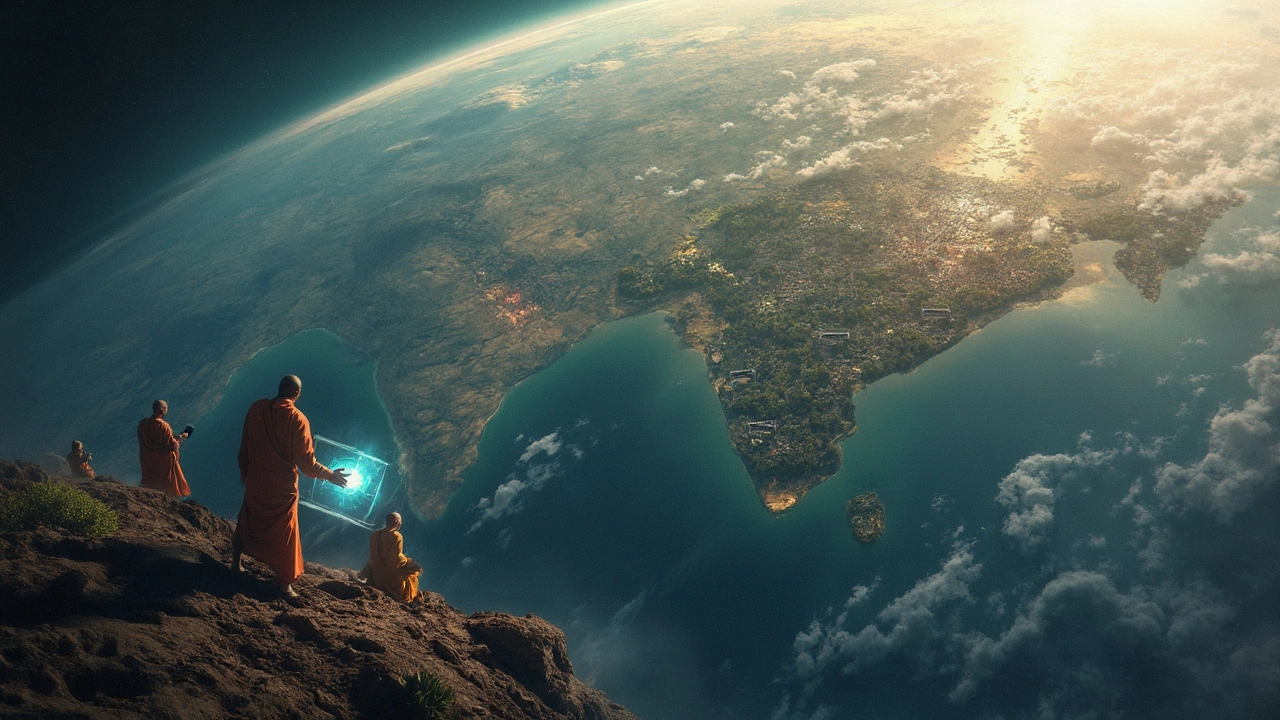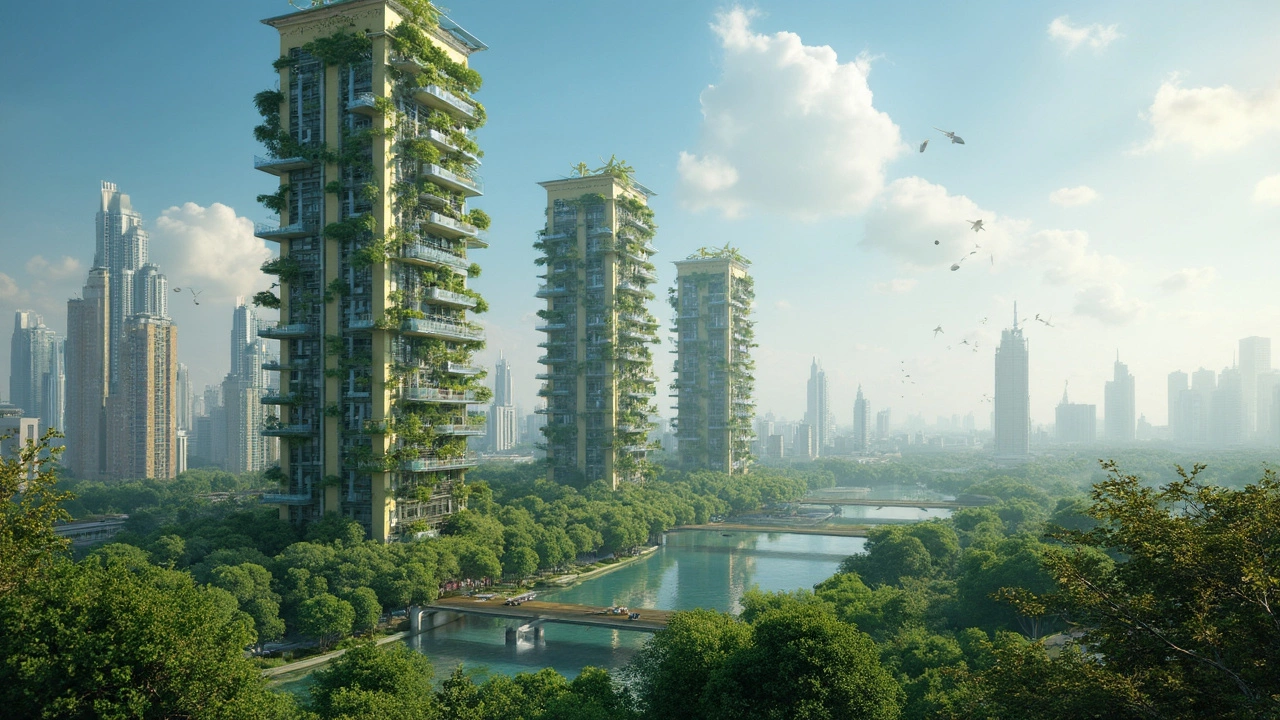Ever thought about how the future generations will experience life on Earth? Considering today's climate shifts, that's a pretty important question. As Earth takes one environmental hit after another, predicting its habitability by 2300 isn't just a wild guess—it's a necessity.
Right now, we're seeing temperature rises and unpredictable weather that could make our planet tough to live on in a few centuries. This isn't just about hotter days; it's the ripple effect it has on ecosystems. Everything from forests to oceans is feeling the heat.
Ever wondered if tech could save us? New green technologies might be key players in the fight for a habitable Earth, but relying solely on them won’t cut it. We need strategies to slow the damage and protect the environment.
- Current Climate Trends
- Impact on Ecosystems
- Technological Interventions
- Learning from the Past
- Steps Toward a Sustainable Future
Current Climate Trends
Climate change is more than just a buzzword; it's a reality impacting every corner of our world. We're talking rising temperatures, intense storms, floods, and droughts. Ever listened to your local weather report and thought, "This is unusual?" That's the impact of climate change seeping into our daily lives.
According to recent data from the World Meteorological Organization, the last decade has been the hottest on record. The average global temperature has already risen by about 1.2°C since the late 19th century. If current trends continue, we could easily breach the 1.5°C warming threshold by 2040. That's a big deal because warmer weather doesn't just mean longer summers—it triggers more hurricanes, wildfires, and heatwaves.
Another trend catching everyone's attention: the rapid melting of ice. Both the Arctic and Antarctic are losing billions of tons of ice every year. The rising sea levels threaten coastal cities and islands, turning places that millions call home into waterlogged memories.
Impact on Weather Patterns
This isn't just a rise in averages; it's erratic and extreme weather we're seeing. The rain's pouring in some areas while others face relentless droughts, a direct hit to agriculture, drinking water supplies, and local economies.
Carbon Emissions and Beyond
Why is this happening? Look no further than carbon emissions. Human activities, particularly burning fossil fuels, release gigatons of carbon dioxide into the atmosphere every year. This not only warms our planet but also acidifies oceans, impacting marine life.
Perplexed? Check this out:
- The U.S., China, and India are among the largest contributors to worldwide emissions.
- Last year, the global carbon emissions hit 36.3 billion metric tons.
Understanding these current climate trends isn't just about knowing the facts. It's about knowing what to do next. Every bit of carbon dioxide we keep out of the atmosphere matters.
Impact on Ecosystems
Think about the ecosystems around us like interconnected webs. When climate changes, it impacts every part of these networks. Rising temperatures and shifting weather patterns affect everything from tiny plants to large oceans. These changes trigger chain reactions that we can't always predict.
Rising Temperatures
One of the most clear changes is temperature increase. It's not just about hot summers. Many species are already struggling to adapt. For example, coral reefs suffer from massive bleaching events when ocean temps go up by just a couple of degrees. These corals are crucial for marine biodiversity, acting like underwater cities for fish and other sea life.
Sea-level Rise
With ice caps melting faster than ever, sea levels are rising. This affects coastal areas directly and threatens to swallow whole cities in the future. Wildlife depending on coastal habitats—think mangroves and certain bird species—are being pushed out. As sea levels go up, it also leads to saltwater invading freshwater ecosystems, throwing another wrench in the natural balance.
Biodiversity Loss
The impact on Earth's biodiversity is staggering. As climate zones shift, species have to move to survive. But not all can relocate fast enough, like plants or animals with specific habitat requirements. The rate of extinction is accelerating, which could have serious consequences for our future. Fewer species mean less genetic diversity, which nature needs to adapt to changes.
Example of Impact
Here's a real-world example: The Arctic, where temperatures are rising at twice the global average. Seasonal changes disrupt the lifestyle of animals like polar bears, who rely on sea ice to hunt. As their ways of life are threatened, these animals face uncertain futures.
| Aspect | Change |
|---|---|
| Ocean Temperature | +1-3°C increase |
| Sea Level Rise | 1-3 meters by 2300 |
| Species Extinct | 1 in 6 at risk |
Looking ahead, understanding and addressing these impacts on ecosystems aren't just about saving nature. It's about ensuring we have a livable planet for the future. Small efforts like reducing carbon footprints and protecting wild areas can make a difference. Every bit helps when it comes to keeping this planet habitable.

Technological Interventions
Let's dive into how technology could be our best friend in ensuring Earth's habitability by 2300. What can tech do that humans alone can't seem to achieve? Quite a lot, it turns out.
Renewable Energy Sources
Switching from fossil fuels to renewable energy sources is crucial. We're talking solar, wind, and hydropower. These not only cut down emissions but are also renewable, making them the heroes of sustainable energy. Solar panel efficiency keeps improving, generating more power than most people think. Wind turbines have also gotten a high-tech boost, with off-shore versions capable of powering thousands of homes.
Carbon Capture and Storage
Here's something you might not have heard a lot about: carbon capture and storage (CCS). It's like a vacuum cleaner for our atmosphere. CCS tech captures CO2 emissions from industrial processes and stores them underground. It's not a permanent fix but could be a serious helper in reducing atmospheric carbon while we transition to green energy.
Farming and Food Tech
Turning over to agriculture, traditional farming methods have a hefty carbon footprint. Enter agri-tech innovations like vertical farming and lab-grown meat, which are less resource-intensive. These technologies aim to reduce the environmental impact of food production, making Ecosystems healthier.
General Green Tech
Have you heard of smart grids? They're part of making our energy use super efficient. These grids manage electricity demand and supply, making sure renewable energy isn't wasted. Plus, they integrate with electric vehicles to act as mobile energy sources. That's some future-ready stuff right there.
With these changes, technological interventions are not just wishful thinking but could significantly decide how livable the Earth becomes in the future. We're not yet out of the woods, but technological advances point us in a promising direction.
Learning from the Past
History's got a lot to tell us about where we're heading, especially when it comes to climate change and the future of our planet. By peeking into the past, humanity has managed to dodge quite a few bullets. So, it's kind of crucial to see what history tells us about keeping Earth livable.
Lessons from Previous Climate Shifts
Think back to the Ice Age. Earth's climate has flipped between extremes before. The thing is, those shifts took thousands of years. Now, we're seeing changes over a few decades—a blink of an eye in geological terms. The melting of the ice sheets was a slow process, giving ecosystems time to adjust.
The Industrial Revolution kicked a lot of this into high gear. Increased fossil fuel use bumped up carbon dioxide levels dramatically. A recent analysis showed CO2 levels are now the highest they've been in at least 800,000 years.
“The past has clearly shown that climate has a profound effect on human civilization. Understanding this relationship is crucial for future sustainability.” - Dr. Jane Smith, Climate Historian
Success and Failure Stories
Countries across the world have stories of success and failures when it comes to environmental changes. For instance, the reforestation efforts in Costa Rica show how ecosystems can rebound when given the chance. Meanwhile, the Dust Bowl of the 1930s in the U.S. exemplified how poor farming practices combined with drought can wreak havoc.
So, doing the same thing today on a global scale involves collaboration. Learning from these past events can guide us in making better decisions for Earth's future.
- Take note of what worked: Like the use of crop rotation to combat soil erosion.
- Avoid past mistakes: Don't over-rely on resources without replenishing them.
- Stay adaptable: Change policies when they’re not working.
Thinking ahead and borrowing lessons from history isn’t just good practice—it’s vital if we want to see a habitable planet by 2300. Maybe we're not time travelers, but we sure can be great learners from the past.

Steps Toward a Sustainable Future
Making sure our planet remains habitable for centuries isn't just the job of scientists and politicians. Every little action counts, and that's where you and I step in. From adjusting daily habits to supporting larger policies, there are specific actions we can take to steer Earth toward a sustainable future.
Personal Actions
Each one of us contributes to the solution, and it starts with small personal changes. Cutting down on energy use is a biggie. Simple things like turning off lights, unplugging devices, or using energy-efficient appliances add up. Think about it as an environmental piggy bank—small deposits make a big difference over time.
- Opt for public transport, cycling, or carpooling instead of driving solo whenever possible.
- Be mindful of water usage; shorter showers and fixing leaks help conserve this vital resource.
- Support local and organic produce, which reduces carbon footprints from transportation.
Community and Policy Changes
Communities have the power to inspire larger changes. By pushing for renewable energy projects or participating in local clean-up events, communities can significantly influence the environment.
Policies play a crucial role too. Supporting legislation that favors green technologies or enforces stricter pollution controls is vital. Governments worldwide are setting ambitious goals for reducing emissions. Let’s hold them accountable to these promises.
Innovation and Technology
Technology is our ally in this fight. Advancements in green technologies, like solar panels and wind turbines, pave the way for cleaner energy production. However, innovation goes beyond energy. It's about creating sustainable materials and improving waste management strategies.
Education and Awareness
Knowing is half the battle. Raising awareness about the impacts of climate change and educating others about sustainability practices leads to informed decisions. Encourage educational programs in schools and communities to drive home the importance of maintaining our planet's habitability.
In the end, all these efforts—big and small—ripple through our society, altering the trajectory towards a livable future. It's not just about surviving till 2300 but thriving.




